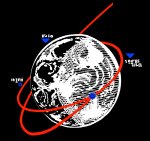
|
Step 1b: Number of Stars
First, determine the number of stars in the star system.
| Roll (3d6) |
Number of Stars |
|---|
| 3-10 |
Single Star |
| 11-15 |
Binary Star |
| 16-18 |
Multiple Star. (Start with two stars; for each, roll again on this chart. Maximum of six stars). |
|
Orbital Period = P = (d3/(M1 + M2))½
Step 1b: Star Size
For each star, roll 3d6 to determine the its size.
| Roll (3d6) |
Object Type |
|---|
| 3-5 |
White dwarf (D) |
| 6 |
Subdwarf (VI) |
| 7-17 |
Main sequence star (V) |
| 18 |
Giant (roll to find giant type) |
|
| |
| Roll (3d6) |
Giant Type |
|---|
| 3 |
Supergiant (Ia) |
| 4 |
Supergiant (Ib) |
| 5 |
Large giant (II) |
| 6-12 |
Giant (III) |
| 13-17 |
Subgiant (IV) |
| 18 |
Unusual object (roll to find object type) |
|
|
| Roll (2d6) |
Unusual Object |
|---|
| 2-3 |
Protosun |
| 4-6 |
Variable Star |
| 7-8 |
Black Dwarf |
| 9-10 |
Nebula |
| 11 |
Neutron Star/Pulsar |
| 12 |
Black Hole |
|
|
Step 1c: Spectral Class
This one-letter designation describes the colour and temperature of the star.
The common spectral classes are, from hottest to coolest: O, B, A, F, G, K, M. (easily remembered via the mnemonic "Oh, Be A Fine Girl, Kiss Me").
Class O, B, and A stars are the hottest, and are white or blue-white in colour. Class F and G are yellow and medium temperature; these are the most likely to have Earthlike planets. K and M are red and only a few thousand degrees cool.
| Class |
Colour |
|---|
| O |
Blue |
| B |
Blue-white |
| A |
White |
| F |
Yellow-white |
| G |
Yellow |
| K |
Orange |
| M |
Red |
|
Several other stellar classes are very rare: Class W, or Wolf-Rayet stars, are white-hot, more than twice the temperature of O stars. R, N, and S are giant stars which are so cool that they cannot support Earth-type life in their vicinity. R and N -- nowadays classed together as C -- are dim red, and S is an even dimmer reddish-brown.
Spectral classes are further broken down into ten numerical subclasses, 0 (hot) through 9 (cool). Thus our sun, a G2 star, is hotter than a G5 and cooler than a G0, which in turn is slightly cooler than an F9 or F8.
For each star in the system, determine the stellar class.
| Main Sequence |
|---|
|
Roll (3d6) |
Spectral Class |
|---|
|
3-12 |
M |
|
13 |
K |
|
14 |
G |
|
15 |
F |
|
16 |
A |
|
17 |
B |
|
18 |
O |
|
| |
| Giants |
|---|
| Roll (2d6) |
Spectral Class |
|---|
| 2-4 |
A |
| 5-8 |
K |
| 9-10 |
B |
| 11 |
M |
| 12 |
O |
|
| |
| Subdwarfs |
|---|
| Roll (1d6) |
Spectral Class |
|---|
| 1-4 |
M |
| 5 |
K |
| 6 |
G |
|
|
|


